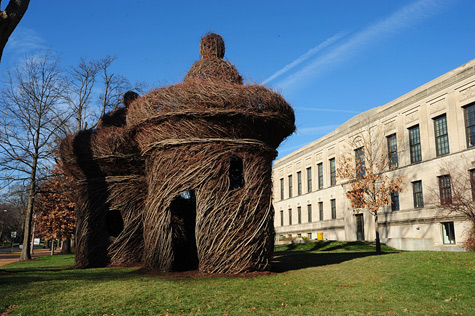
David Kilper
Double or Nothing, a new “stickwork” by internationally known artist Patrick Dougherty, was commissioned this fall by the Sam Fox School of Design & Visual Arts. Located on the south lawn of Givens Hall, the piece was constructed by Dougherty and Sam Fox School students and will remain on view through December 2013.
There is an undeniable romanticism to the sculpture of Patrick Dougherty. Working with the simplest of materials — sticks, branches and saplings — the North Carolina-based artist creates playful architectural forms that variously suggest nests, primitive shelters and fairy-tale castles.
This fall, Dougherty enlisted dozens of students to help construct Double or Nothing, a new commission for Washington University in St. Louis’ Sam Fox School of Design & Visual Arts. Located along Forsyth Boulevard, on the south lawn of Givens Hall, the piece consists of two large woven-wood structures, each rising approximately 20 feet in the air.
“I think of myself as a sculptor, and I think of sticks as worthy sculptural material,” says Dougherty, the Sam Fox School’s 2011 Louis D. Beaumont Artist in Residence.
“People have a visceral response and connection to sticks,” says Dougherty, who to date has created approximately 200 “stickworks,” as he calls them. “People tell stories about their favorite trees. I just had to figure out what birds and beavers already knew about fitting sticks together.”
Double or Nothing grew out of a master class, titled “Stickwork on Campus,” co-taught by Dougherty and Ron Fondaw, professor of art. (Funding for the project was provided by the Sam Fox School Dean’s Office and by the Colleges of Art and Architecture.)
Sixteen graduate and advanced undergraduate students — drawn from art, architecture and the new Master of Landscape Architecture program — met with Dougherty for an initial site visit last August, then attended a series of lectures on public art and architecture.
In late October, students began gathering materials (i.e., sticks) in preparation for Dougherty’s formal residency, which lasted about three weeks. Construction began Nov. 1 and was led by the artist, who trained the class in methods for bending, twisting, braiding, wefting and otherwise shaping wood. Joining the group were several dozen volunteers, including freshmen and sophomores from Associate Professor Cheryl Wassenaar’s “Eco Art” studio, for a total workforce of about 50 people.
“It’s been the perfect synthesis of art, architecture and landscape architecture,” Fondaw says. “And Patrick is the consummate teacher. He’s patient, he’s persistent and he’s caring.”
Fondaw estimates that, in all, students harvested about 20,000 sticks, mostly dogwood and willow, from various sites in Missouri and Illinois. Cut green and lightly pruned, the sticks were bundled, loaded onto a flatbed trailer and transported back to campus.
Construction unfolded in three phases. First, Dougherty and students established their perimeter by digging postholes and sinking thick branches vertically into the ground. Onto this base they wove a “crust” of smaller, more tightly thatched branches, thus giving the piece shape and weight. The third and final phase consisted of editing, or “aestheticizing,” that crust, in order to highlight, and occasionally de-emphasize, particular elements.
“You’re constantly developing the line logic, trying to create that illusion of movement,” Dougherty says. The artwork should not so much sit on the ground as appear to emanate from it, like a root, while the viewer should be pulled along by smooth transitions from exterior to interior spaces. “Windows, doors, rims — we work really hard on those focal points.”
The finished sculpture, which was dedicated Nov. 21, consists of two tower-like structures, each comprising a relatively thin outer wall, approximately 15 feet in diameter, and a stout central column, about the width of a large tree trunk. The outer wall flares dramatically at its top, while the inner column rises several feet above it, at once suggesting a domed roof and the brambly pistil of some massive woven flower.
“It’s very much like drawing,” Dougherty says. “Any line you can draw with a pencil, you can draw with a stick — and erase if it isn’t working.” And, like a graphite mark that begins heavily but lightens as the hand travels away from the body, “sticks are naturally tapered and imply a sense of motion. All the conventions that you might use with your pencil — creating lines, excising lines, adding new lines and feathering them together — you can use with sticks.”
Peter MacKeith, associate dean of the Sam Fox School and associate professor of architecture — who organized Dougherty’s residency — notes that, “Double or Nothing represents the enthusiasms and collaborative mission of the Sam Fox School in a very public way. The project unites techniques of making drawn from art, architecture and landscape architecture.
“But it also embodies the enthusiasm and good will of the entire university community,” says MacKeith, who worked with facilities, community relations and other areas to bring Double or Nothing to fruition.
“This is a process as much as a product for the school and the university.”